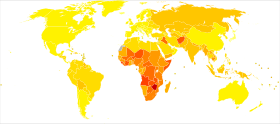
Back معدل السنة الحياتية للإعاقة Arabic Anys de vida ajustats per discapacitat Catalan Ztracená léta života v důsledku nemoci Czech DALY German Disability-adjusted life year English Años de vida ajustados por discapacidad Spanish DALY-arvo Finnish Espérance de vie corrigée de l'incapacité French שנות חיים מותאמות לנכות HE Disability-adjusted life year Italian

No data
Fewer than 9,250
9,250–16,000
16,000–22,750
22,750–29,500
29,500–36,250
36,250–43,000
43,000–49,750
49,750–56,500
56,500–63,250
63,250–70,000
70,000–80,000
More than 80,000
Disability-adjusted life years (DALYs) are a way of measuring the effects of diseases. They are calculated as the number of years lost due to ill-health, disability, or early death. The measure was developed in the 1990s as a way of comparing the overall health and life expectancy of different countries.
DALYs are used in the field of public health and health impact assessment . They include the potential years of life lost due to premature death and years of 'healthy' life lost by virtue of being in states of poor health or disability. In so doing, mortality and morbidity are combined into a single figure.[2]
- ↑ "Disease and injury country estimates". World Health Organization. Archived from the original on 2009-11-11. Retrieved Nov 11, 2009.
- ↑ "Metrics: Disability-Adjusted Life Year (DALY)". WHO. Archived from the original on Feb 20, 2020. Retrieved 2020-01-02.
© MMXXIII Rich X Search. We shall prevail. All rights reserved. Rich X Search